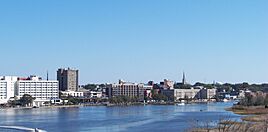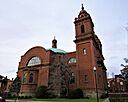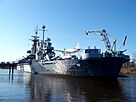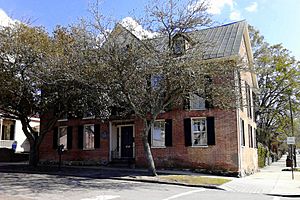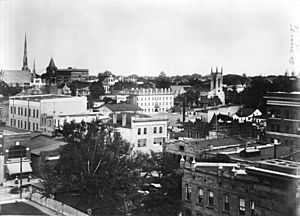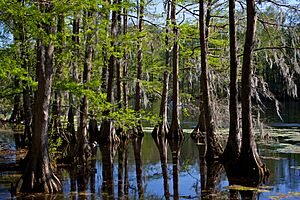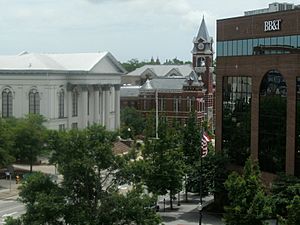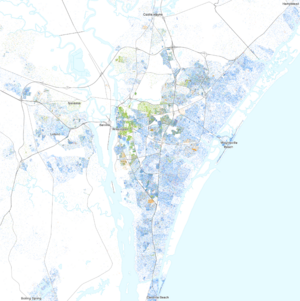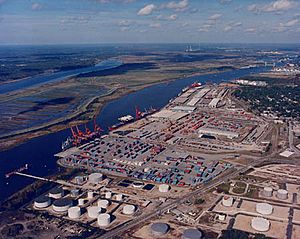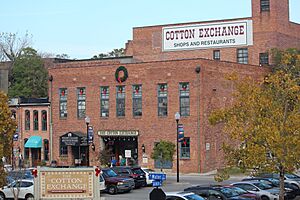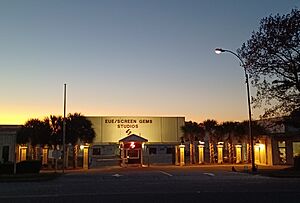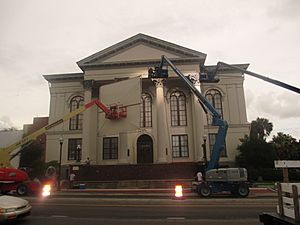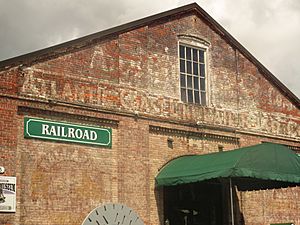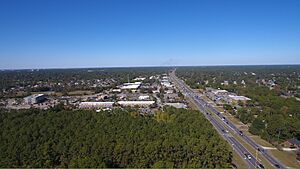Wilmington, North Carolina facts for kids
Quick facts for kids
Wilmington
|
|||||
|---|---|---|---|---|---|
|
Wilmington skyline seen from the Cape Fear River
City Hall/Thalian Hall
UNCW Clock Tower
Cape Fear Memorial Bridge
|
|||||
|
|||||
| Nickname(s):
The Port City, ILM, Hollywood of the East, Wilmywood
|
|||||
| Motto(s):
"Persevere"
|
|||||
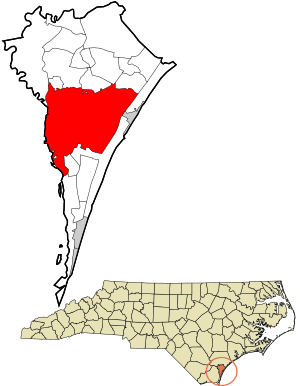
Location in New Hanover County and North Carolina
|
|||||
| Country | |||||
| State | |||||
| County | New Hanover | ||||
| Incorporated | February 20, 1739 | ||||
| Named for | Spencer Compton, 1st Earl of Wilmington | ||||
| Government | |||||
| • Type | Council–manager | ||||
| Area | |||||
| • Total | 52.97 sq mi (137.19 km2) | ||||
| • Land | 51.41 sq mi (133.14 km2) | ||||
| • Water | 1.56 sq mi (4.05 km2) 2.95% | ||||
| Elevation | 43 ft (13 m) | ||||
| Population
(2020)
|
|||||
| • Total | 115,451 | ||||
| • Estimate
(2023)
|
122,698 | ||||
| • Rank | 241st in the United States 8th in North Carolina |
||||
| • Density | 2,245.91/sq mi (867.15/km2) | ||||
| • Urban | 255,329 (US: 159th) | ||||
| • Urban density | 1,795.0/sq mi (693.1/km2) | ||||
| • Metro | 467,337 (US: 115th) | ||||
| Time zone | UTC−5 (EST) | ||||
| • Summer (DST) | UTC−4 (EDT) | ||||
| ZIP codes |
28401–28412
|
||||
| Area codes | 910, 472 | ||||
| FIPS code | 37-74440 | ||||
| GNIS feature ID | 2405754 | ||||
| Primary Airport | Wilmington International Airport | ||||
Wilmington is a lively port city in New Hanover County, North Carolina, United States. It's a "port city" because it has a harbor where ships can load and unload goods. As of 2020, about 115,451 people live here, making it the eighth-largest city in North Carolina. Wilmington is the main city of the Wilmington area, which includes New Hanover, Brunswick, and Pender counties. This larger area had about 467,337 people in 2023.
Wilmington is located between the Cape Fear River and the Atlantic Ocean. It grew into an important trading port during the colonial times. In the late 1800s, Wilmington was a thriving city with a diverse population. However, in 1898, a group of white supremacists took over the local government. This event, known as the Wilmington insurrection of 1898, led to the removal of elected leaders and harm to the property of Black citizens. Many people were hurt or killed. After this, Charlotte became North Carolina's largest city.
Today, downtown Wilmington has a beautiful 1.75-mile riverwalk, which is a popular spot for visitors. In 2003, the U.S. Congress named Wilmington a "Coast Guard City." It was also the first city in the country to be called a "World War II Heritage City" in 2020. You can visit the USS North Carolina battleship, which is now a memorial, and explore the Cape Fear Museum of History and Science.
The city is also home to the University of North Carolina Wilmington. Wilmington is a big center for making movies and TV shows, sometimes called "Hollywood of the East." Many famous films and TV series have been filmed here, like Dawson's Creek, One Tree Hill, Iron Man 3, and Outer Banks.
Contents
- History of Wilmington
- Wilmington's Geography and Climate
- Cityscape: Exploring Wilmington
- People of Wilmington
- Wilmington's Economy
- Arts and Culture in Wilmington
- Sports in Wilmington
- Education in Wilmington
- Media in Wilmington
- Transportation in Wilmington
- Healthcare in Wilmington
- Famous People from Wilmington
- Sister Cities
- See also
History of Wilmington
How Wilmington Began
The city of Wilmington started in the 1730s. It had a few different names, like New Carthage and Newton. In 1740, it was named Wilmington to honor Spencer Compton, 1st Earl of Wilmington.
Before Europeans arrived, different groups of indigenous peoples lived along the river for thousands of years.
In the early 1500s, an Italian explorer named Giovanni da Verrazzano was likely the first European to see this area. The first lasting European settlement was built in the 1720s. In September 1732, a community was started on land owned by John Watson along the Cape Fear River. It was first called New Carthage, then New Liverpool, and later Newton. In 1739 or 1740, the town officially became Wilmington.
Many early settlers came from other colonies like Virginia and South Carolina. Others came from the northern colonies, the West Indies, and Northern Europe. Many were indentured servants, who worked for a period to pay for their travel. As fewer indentured servants arrived, more slaves were brought in for labor. By 1767, over 62% of the population in the Lower Cape Fear region were African slaves. Many worked in the port or in ship-related jobs.
The economy of the area relied on naval stores (materials like tar and pitch for ships) and lumber. This was true both before and after the American Revolution. During the Revolutionary War, the British had soldiers stationed at Fort Johnston near Wilmington.
Wilmington's Role in the American Revolution
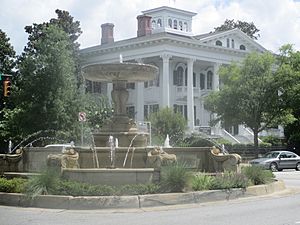
Wilmington was a very important port, so it played a big part in fighting against the British before the American Revolution. The city had strong leaders who helped guide the resistance movement in North Carolina. One of the most important was Cornelius Harnett. He spoke out against the Sugar Act in 1764.
When the British Parliament passed the Stamp Act in 1765, which taxed shipping, Wilmington saw a big protest. On October 19, 1765, hundreds of townspeople gathered. They burned a dummy of someone who supported the act and cheered for "Liberty, Property, and No Stamp Duty."
On October 31, another crowd held a pretend funeral for "Liberty." But before Liberty was buried, they found it still had a "pulse," and everyone celebrated!
When William Houston was appointed to collect the stamp tax, he visited Wilmington. He was met by a large crowd. The town bell rang, drums beat, and flags flew. The people demanded that he promise not to enforce the Stamp Act. To protect himself, Houston resigned his position.
Governor William Tryon tried to calm the protests, but it didn't work. On November 18, 1765, he spoke to important residents. They told him the law took away their rights. When the stamps arrived on November 28, Tryon ordered them to stay on the ship. Shipping on the Cape Fear River stopped, and the courts could not work.
Because of all the unrest, Governor Tryon moved his government to New Bern instead of Wilmington.
On February 18, 1766, two merchant ships arrived without stamped papers. A British ship seized them. In response, many people from southern counties met in Wilmington. They formed a group called the Sons of Liberty. They promised to stop the Stamp Act from being used. The next day, about a thousand men, including Wilmington's mayor, went to confront Tryon. The governor refused to give in, but the crowd took back the seized ships. They forced royal officers to promise they would never use stamped paper. The British Parliament removed the Stamp Act in March 1766.
Wilmington Before the Civil War
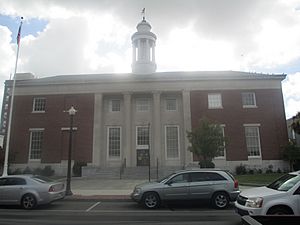
In the 1830s, people in Wilmington wanted to use railroads. At this time, Wilmington was a busy port. Plans were made to build a railroad from Raleigh to Wilmington. When Raleigh citizens didn't invest enough money, the railroad's end point was changed to Weldon. When the railroad was finished in 1840, it was the longest single railroad line in the world! The railroad also had steamboats that traveled between Wilmington and Charleston. These boats carried both people and goods.
By the mid-1800s, the cemeteries were full. So, in 1853, a group of citizens created a new cemetery called Oakdale Cemetery. It was the first rural cemetery in North Carolina.
The Wilmington Gas Light Company started in 1854. Soon, gas made from wood and rosin powered the streetlights, replacing old oil lamps. In 1855, construction began on a new city hall. An opera house, named Thalian Hall, was built next to it. In 1857, the city opened its first public school for white students, called the Union Free School.
Before the Civil War, most people in Wilmington were Black. While most were slaves, there was a large group of free people of color. They started businesses and worked in trades. For a time, they could vote, carry weapons, and serve in the militia. After Nat Turner's rebellion, laws were passed to limit the rights of free Black people.
Wilmington During the Civil War
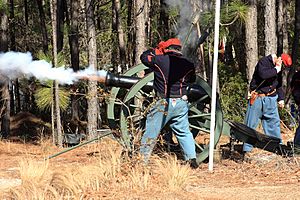
During the Civil War, Wilmington's port was a key place for blockade runners. These ships brought much-needed supplies from England to the South, despite the Union's efforts to stop them. Union forces captured the city in February 1865, after Fort Fisher fell and closed the port. Wilmington was the last Confederate port to be taken. Most of the fighting happened away from the city, so many old houses and buildings from before the war survived.
In August 1862, a serious outbreak of yellow fever hit Wilmington. It was thought to have come from a ship called Kate. Many people got sick, and between 650 and 800 died. Later, scientists learned that mosquitoes spread yellow fever.
After the Civil War: Changes and Challenges
After the Civil War, during the Reconstruction era, formerly enslaved people and free Black citizens built a strong community in Wilmington. About 55% of the city's residents were Black. Wilmington was the largest city in North Carolina and an important economic center.
Black citizens held many important jobs in the city. Some were aldermen (city council members), and others worked as police officers, mail carriers, and in the courts.
Black people also made up over 30% of Wilmington's skilled workers. This included mechanics, carpenters, jewelers, painters, and more. They owned most of the city's restaurants and half of its tailor shops. Two brothers, Alexander and Frank Manly, owned the Wilmington Daily Record, one of the few Black-owned newspapers in the state.
In the 1890s, a group of white Democrats wanted to regain control of the state government. Violence increased around elections as armed white groups, called Red Shirts, tried to stop Black and Republican voters.
The Wilmington Insurrection of 1898 (also called the Wilmington Race Riot) happened because of these tensions. In 1898, white Democrats planned to take over the city government if their candidates didn't win. Two days after an election where a white Republican was elected mayor and both white and Black aldermen won, over 1500 white men attacked and burned the only Black-owned daily newspaper. They forced the elected city officials to resign at gunpoint and replaced them with their own choices. This was the only time in U.S. history that a local government was overthrown in this way.
White attackers killed an estimated 10 to 100 Black people. No white people died in the violence. After the attacks, more than 2100 Black people left the city for good. This changed the city's population from mostly Black to mostly white.
After these events, North Carolina passed new laws that made it very hard for Black citizens to vote. This included poll taxes and literacy tests. Black people were mostly kept out of the political system until the federal Voting Rights Act of 1965 was passed.
Wilmington in the 20th Century
Wilmington is home to the Bijou Theater, which started as a tent in 1904 and became a permanent building in 1906. It operated until 1956, making it one of the oldest continuously running movie theaters in the country. In 1910, Charlotte became North Carolina's largest city, passing Wilmington.
In the mid-1900s, people started working to save many historic buildings. Because of these efforts, many buildings were listed on the National Register of Historic Places. Since the 1980s, Wilmington has been a major place for filming movies and TV shows. In 1990, Interstate 40 was extended to New Hanover County, connecting the area to the national highway system.
During World War II, Wilmington was home to the North Carolina Shipbuilding Company. This shipyard was part of a U.S. government program to build ships quickly. Workers in Wilmington built 243 ships in five years.
Three prisoner-of-war (POW) camps were in the city from 1944 to 1946. At their busiest, these camps held 550 German prisoners.
Wilmington in the 21st Century
Starting in the 1990s, Wilmington grew quickly, partly because of the film industry and the completion of I-40. The city added nearby areas like Seagate in 1998 and Masonboro in 2000.
In 2017, a chemical called GenX was found in the Cape Fear River, a main water source for the region. It was discovered that a plant near Fayetteville, North Carolina had been releasing this chemical since 1980.
In 2020, then-President Donald Trump named Wilmington the first World War II Heritage City in the country. This was to recognize the city's important contributions during the war.
Historic Places to Visit
Many places in Wilmington are listed on the National Register of Historic Places. These include the Bellamy Mansion, City Hall/Thalian Hall, Fort Fisher, and the USS North Carolina (BB-55) National Historic Landmark. The Wilmington Historic District itself covers nearly 300 blocks of historic buildings.
Wilmington's Geography and Climate
Wilmington is where Interstate 40 ends in the east. This major highway stretches 2,554 miles all the way to Barstow, California.
The city covers about 52.97 square miles. Most of this is land (51.41 square miles), and a small part is water (1.56 square miles).
Nearby beaches like Wrightsville Beach, Carolina Beach, and Kure Beach are popular places to visit in the Wilmington area.
Wilmington's Weather
Wilmington has a humid subtropical climate. This means it has hot, humid summers and mild winters.
- Winters are usually mild. In January, highs are around 50s °F (12 °C) and lows are around 30s °F (1 °C). It doesn't snow much, and when it does, it's usually light.
- Spring lasts from late February to early May. There's a lot of pollen in the air during this time, which can make cars and rooftops look yellow.
- Summers are very humid. Daily high temperatures are usually in the upper 80s to lower 90s °F (31–34 °C). Lows are around 70 to 75 °F (22 °C). It can feel even hotter because of the humidity. Wilmington can experience hurricanes or tropical storms, mostly from August to early October. These storms bring strong winds and heavy rains.
- Autumn also starts humid, with the highest risk of tropical storms in September.
- The average temperature in January is 46.0 °F (8 °C).
- The average temperature in July is 81.1 °F (27 °C).
- Wilmington gets about 60.15 inches of rain each year. August and September are the wettest months.
- It rarely snows, with an average of 1.6 inches per winter.
Cityscape: Exploring Wilmington
Wilmington has a large historic district with almost 300 blocks of old buildings. Some old warehouses downtown have been replaced by new projects. One of these is the Skyline Center, which is now the city government's main building. Other new projects include a modern convention center and apartments.
Downtown Wilmington
| Downtown Monuments and Historic Buildings |
|---|
| The Bellamy Mansion |
| Cotton Exchange of Wilmington |
| The Temple of Israel |
| The Murchison Building |
People of Wilmington
| Historical population | |||
|---|---|---|---|
| Census | Pop. | %± | |
| 1800 | 1,689 | — | |
| 1820 | 2,633 | — | |
| 1830 | 3,791 | 44.0% | |
| 1840 | 5,335 | 40.7% | |
| 1850 | 7,264 | 36.2% | |
| 1860 | 9,552 | 31.5% | |
| 1870 | 13,446 | 40.8% | |
| 1880 | 17,350 | 29.0% | |
| 1890 | 20,056 | 15.6% | |
| 1900 | 20,976 | 4.6% | |
| 1910 | 25,748 | 22.7% | |
| 1920 | 33,372 | 29.6% | |
| 1930 | 32,270 | −3.3% | |
| 1940 | 33,407 | 3.5% | |
| 1950 | 45,043 | 34.8% | |
| 1960 | 44,013 | −2.3% | |
| 1970 | 46,169 | 4.9% | |
| 1980 | 44,000 | −4.7% | |
| 1990 | 55,530 | 26.2% | |
| 2000 | 75,838 | 36.6% | |
| 2010 | 106,476 | 40.4% | |
| 2020 | 115,451 | 8.4% | |
| 2023 (est.) | 122,698 | 15.2% | |
| U.S. Decennial Census 2020 |
|||
Wilmington's Population in 2020
| Race / Ethnicity (NH = Non-Hispanic) | Pop 2000 | Pop 2010 | Pop 2020 | % 2000 | % 2010 | % 2020 |
|---|---|---|---|---|---|---|
| White alone (NH) | 52,639 | 75,432 | 79,791 | 69.41% | 70.84% | 69.11% |
| Black or African American alone (NH) | 19,423 | 20,850 | 18,828 | 25.61% | 19.58% | 16.31% |
| Native American or Alaska Native alone (NH) | 242 | 379 | 317 | 0.32% | 0.36% | 0.27% |
| Asian alone (NH) | 677 | 1,246 | 1,826 | 0.89% | 1.17% | 1.58% |
| Pacific Islander alone (NH) | 60 | 61 | 98 | 0.08% | 0.06% | 0.08% |
| Some Other Race alone (NH) | 108 | 195 | 554 | 0.14% | 0.18% | 0.48% |
| Mixed Race or Multi-Racial (NH) | 698 | 1,826 | 4,493 | 0.92% | 1.71% | 3.89% |
| Hispanic or Latino (any race) | 1,991 | 6,487 | 9,544 | 2.63% | 6.09% | 8.27% |
| Total | 75,838 | 106,476 | 115,451 | 100.00% | 100.00% | 100.00% |
As of the 2020 census, Wilmington had 115,451 people living in 54,673 households.
Religious Life in Wilmington
Less than half of Wilmington's people are part of a religion (47.30%). Most of these are Christian. The biggest Christian groups are Baptists (14.66%) and Methodists (8.29%), followed by Roman Catholics (7.42%). There are also many Presbyterians, Episcopalians, Pentecostals, and Lutherans.
Wilmington has important historical religious buildings. These include the Basilica Shrine of St. Mary and the Temple of Israel.
Wilmington's Economy
Wilmington's industries include making electrical, medical, electronic, and telecom equipment. They also produce clothing, food products, paper, nuclear fuel, and medicines. Wilmington is part of North Carolina's "Research Coast," near the Research Triangle Park.
Tourism is also very important to Wilmington's economy. People visit because it's close to the ocean and has a fun nightlife. Shopping areas include the Cotton Exchange of Wilmington and Independence Mall.
Wilmington is a large seaport on the Cape Fear River, which flows into the Atlantic Ocean. It has private shipping terminals and the North Carolina State Ports Authority's Port of Wilmington.
The Greater Wilmington Chamber of Commerce is the oldest Chamber in North Carolina, started in 1853. Companies like Live Oak Bank and HomeInsurance.com have their main offices in Wilmington.
Top Employers in Wilmington
Here are the top employers in Wilmington, based on a 2023 report:
| # | Employer | Employees |
|---|---|---|
| 1 | Novant Health | 8,581 |
| 2 | New Hanover County Schools | 3,702 |
| 3 | University of North Carolina Wilmington | 2,236 |
| 4 | New Hanover County | 1,982 |
| 5 | General Electric | 1,888 |
| 6 | Thermo Fisher Scientific (PPD) | 1,800 |
| 7 | City of Wilmington | 1,116 |
| 8 | Cape Fear Community College | 1,083 |
| 9 | Corning | 1,000 |
| 10 | Wilmington Health | 1,000 |
Arts and Culture in Wilmington
Performing Arts Scene
Wilmington has a very active arts scene. Its main theater, Thalian Hall, hosts about 250 events each year. This theater has been open since 1858 and has three performance spaces.
The Hannah Block Historic USO/Community Arts Center is another important venue. It has five studios for theater, music, and art classes. The Hannah Block Second Street Stage is home to the Thalian Association Children's Theater. This theater seats 200 people and is used by many community groups.
The University of North Carolina at Wilmington has a modern Cultural Arts Building. It opened in 2006 and includes a music hall, art gallery, and two theaters. They put on four theater productions each year.
The Brooklyn Arts Center at St. Andrews is a 125-year-old building in downtown Wilmington. It's on the National Register of Historic Places. This center is used for weddings, concerts, art shows, and other community events.
Wilmington is also home to the Wilmington Conservatory of Fine Arts. This studio teaches dance, including a special ballet technique. It also hosts the Turning Pointe Dance Company, which performs artistic shows for the community.
Wilmington's Film and TV Industry
Wilmington is home to Cinespace Wilmington. The city became famous for movies and TV shows in the 1980s and 1990s, earning it the nickname "Hollywood East." Many popular TV series were filmed here, like Matlock, Dawson's Creek, One Tree Hill, and Outer Banks.
Many movies were also filmed in or near Wilmington. Some examples include Blue Velvet, Teenage Mutant Ninja Turtles, Iron Man 3, and Scream.
Since 1995, Wilmington hosts an annual independent film festival called "Cucalorus." This festival also includes a Kids Festival with hands-on filmmaking workshops.
In 2014, North Carolina stopped offering film incentives, which caused many productions to move to other cities like Atlanta, Georgia. However, efforts were made to bring the industry back with the North Carolina Film and Entertainment Grant.
In the early 2020s, filming in Wilmington started to increase again. 2021 was a very busy year for the city's film industry. In 2022, Dark Horse Studios, Wilmington's second film studio, planned a big expansion. In 2023, Cinespace Studios bought the EUE/Screen Gems Studios location in Wilmington.
Music Scene
Chamber Music Wilmington started in 1995. It presents a "Simply Classical" series of four concerts each season. These concerts feature world-class musicians and are held at UNCW's Beckwith Recital Hall.
The Wilmington Symphony Orchestra began in 1971. It offers five classical performances and a free family concert throughout the year.
The North Carolina Jazz Festival is an annual three-day event that started in 1980. It features famous jazz musicians.
The Cape Fear Blues Society helps promote blues music in Wilmington. They host weekly blues jams and an annual Cape Fear Blues Challenge. Their biggest event is the Cape Fear Blues Festival, which features local and national blues artists.
Museums and Historic Sites
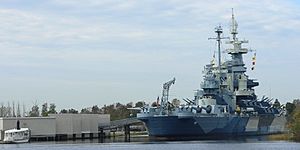
- Cameron Art Museum
- Bellamy Mansion Museum of History & Design Arts
- Cape Fear Museum of History and Science
- The Children's Museum of Wilmington
- First Baptist Church, founded in 1808
- First Presbyterian Church, a historic church
- Grace United Methodist Church, founded in 1797
- Hannah Block Historic USO/Community Arts Center
- Latimer House Museum and Gardens
- St. James Episcopal Church, the oldest church in Wilmington
- St. Mary Catholic Church, a historic Catholic church
- Temple of Israel, the oldest synagogue in North Carolina
- USS North Carolina Memorial
- Wilmington Railroad Museum
The Second and Orange Street USO Club was built during World War II for soldiers. It opened in December 1941. From 1941 to 1945, the USO hosted 35,000 uniformed visitors each week. The building has been restored and now serves as a museum. It displays World War II items and other artifacts.
Festivals and Events
Wilmington hosts many annual festivals. The most famous is the Azalea Festival. This festival, sponsored by the Cape Fear Garden Club, includes a garden tour, historic home tour, musical performances, a parade, and fireworks. It happens every year in April.
Sports in Wilmington
| Club | League | Venue | Founded | Titles |
|---|---|---|---|---|
| Wilmington Sharks | CPL, Baseball | Buck Hardee Field at Legion Stadium | 1997 | 2 |
| Wilmington Hammerheads | USL, Soccer | Legion Stadium | 1996 | 1 |
| Wilmington Sea Dawgs | TRBL, Basketball | Wilmington YMCA | 2006 | 0 |
The Wilmington Sharks are a baseball team in the Coastal Plain League (CPL). They started in 1997. The team is made up of top college baseball players who use wood bats to get ready for professional baseball. They play at Buck Hardee Field at Legion Stadium.
The Wilmington Sea Dawgs are a basketball team in the Tobacco Road Basketball League (TRBL). They started playing in 2006.
The Wilmington Hammerheads were a professional soccer team in Wilmington. They were founded in 1996. The team stopped playing professionally in 2017, but the organization still manages its youth soccer team.
The University of North Carolina Wilmington has 19 college sports teams. They are part of the NCAA Division 1. UNCW competes in the Colonial Athletic Association.
The University of North Carolina Wilmington is also home to the Seamen Ultimate Frisbee team. This team won the National Championship in 1993.
The Cape Fear Rugby Football Club is a rugby team that plays in USA Rugby South Division II. They started in 1974. They host the annual Cape Fear Sevens Tournament in July, with teams from all over the world.
Wilmington has also been home to professional minor league baseball teams. The Wilmington Pirates were a popular team from 1946–50. Famous players like Jason Varitek played for Wilmington's Port City Roosters in the 1990s.
The beach near Wilmington hosts the annual O’Neil/Sweetwater Pro-Am and Music Festival. It's the second-largest surfing contest on the East Coast.
Education in Wilmington

Universities and Colleges
- University of North Carolina at Wilmington
- Cape Fear Community College
- Shaw University (a smaller campus)
- University of Mount Olive (a smaller campus)
- University of North Carolina at Pembroke (a smaller campus)
- Miller-Motte Technical College
Schools for Kids
Public schools in Wilmington are run by the New Hanover County School System. Public high schools include Emsley A. Laney High School, Eugene Ashley High School, Girls’ Leadership Academy (GLOW), Isaac Bear Early College High School, John T. Hoggard High School, and New Hanover High School.
Wilmington also has many private schools. Some of these are Cape Fear Academy, St. Mark Catholic School, and the Wilmington Academy of Arts and Sciences.
Media in Wilmington
Newspapers
The Star-News is Wilmington's daily newspaper. It's read throughout the Lower Cape Fear region. Port City Daily is an online newspaper. Two historically Black newspapers, The Wilmington Journal and The Challenger Newspapers, are published weekly. Encore Magazine is a weekly publication about arts and entertainment.
Radio Stations
AM Radio
- 630 AM WMFD – Sports ("ESPN Radio, AM 630")
- 1340 AM WLSG – Regional Mexican music ("La Raza 94.1")
FM Radio
- 89.7 FM WDVV – Worship & Praise Music ("The Dove, 89.7")
- 90.5 FM WWIL-FM – Christian Music ("Life 90.5")
- 91.3 FM WHQR – Public Radio
- 93.1 FM WBPL-LP – Wilmington Catholic Radio
- 94.1 FM W231CL – Regional Mexican music ("La Raza 94.1")
- 95.5 FM W238AV – Contemporary Christian music ("K-LOVE")
- 95.9 FM W240AS – Soft Adult Contemporary music ("95.9 The Breeze")
- 97.3 FM WMNX – Hip Hop/R & B ("Coast 97.3")
- 100.5 FM W263BA – Contemporary Christian music ("K-LOVE")
- 101.3 FM WWQQ-FM – Country music ("Double Q, 101")
- 102.7 FM WGNI – Hot Adult Contemporary music ("102.7 GNI")
- 104.5 FM WYHW – Christian Talk radio ("104.5")
Television Stations
Wilmington is the 130th largest TV market in the United States. Here are the local TV stations:
- WWAY, Channel 3, (ABC affiliate, with CBS on 3.2 and CW on 3.3)
- WECT, Channel 6, (NBC affiliate)
- WILM-LD, Channel 10, (Independent station)
- WSFX-TV, Channel 26, (Fox affiliate)
- WUNJ-TV, Channel 39, (PBS station, part of the UNC-TV Network)
On September 8, 2008, Wilmington was the first market in the U.S. to switch completely to digital TV signals. This was a test by the Federal Communications Commission (FCC) to prepare for the nationwide digital switch.
Transportation in Wilmington
Airport Services
The Wilmington International Airport (ILM) serves the area. Airlines like American Airlines, Delta Air Lines, United Airlines, and Avelo Airlines offer flights here. American Airlines carries a lot of the airport's passengers. The airport handles over 930,000 travelers each year. It also has a special International Terminal for clearing international flights. The airport is 4 miles from downtown and can be reached by Wave Transit buses.
Major Roads (U.S. Routes)
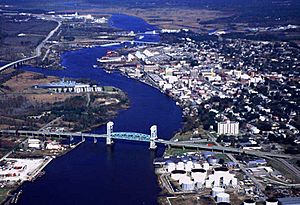
 US 17
US 17
 US 17 Bus.
US 17 Bus.
 US 17 Byp. (future Hampstead Bypass)
US 17 Byp. (future Hampstead Bypass) US 74
US 74 US 76
US 76 US 117
US 117 US 421
US 421


 US 421 Truck
US 421 Truck
North Carolina State Highways
 NC 132
NC 132 NC 133
NC 133 NC 417 (temporary highway for US 17 Bypass)
NC 417 (temporary highway for US 17 Bypass)
Other Ways to Get Around
Public transportation is provided by Cape Fear Public Transportation Authority, known as Wave Transit. They operate buses, shuttles, and a free downtown trolley. You can also take a Greyhound Lines bus to Raleigh. Wilmington also has bus connections to Wilson, North Carolina for Amtrak trains.
The NCDOT Cape Fear Run bicycle route connects Apex to Wilmington.
The city of Wilmington offers places for boats to dock in downtown along the Cape Fear River. Taxi services are also available. In 2021, rules were made easier to help taxis compete with ride-sharing companies like Uber and Lyft.
The Gary Shell Cross-City Trail is a path for bikes and walkers. It connects many parks and cultural spots in Wilmington. It also links to other trails like the River to Sea Bikeway.
Healthcare in Wilmington
New Hanover Regional Medical Center is a hospital in Wilmington. It started in 1967 as a public hospital. It was the first hospital in the city to treat patients of all races. In February 2021, Novant Health, a private organization, took over the hospital.
Famous People from Wilmington
Artists and Writers
- Wiley Cash, author
- Minnie Evans, folk artist
- Robert Ruark, author and hunter
Media and Entertainment Stars
- David Brinkley, famous TV newscaster
- Charlie Daniels, country music legend
- Sammy Davis Sr., dancer
- Maddie Hasson, actress
- Caterina Jarboro, first Black opera singer to perform on an American opera stage
- Charles Kuralt, award-winning journalist
- Sha-Rock (Sharon Green), considered the "first female rapper"
Military Heroes
- Edwin Anderson Jr., Medal of Honor winner
- Eugene Ashley Jr., Medal of Honor winner
- William D. Halyburton Jr., Medal of Honor winner
- Joseph McNeil, civil rights leader and Air Force major general
- Charles P. Murray Jr., Medal of Honor winner
- John Steele, paratrooper, featured in the film The Longest Day
Sports Legends
- Kadeem Allen, basketball player
- Connor Barth, NFL kicker
- Derek Brunson, UFC fighter
- Jonathan Cooper, NFL offensive guard
- Alge Crumpler, NFL tight end
- Roman Gabriel, former NFL quarterback and MVP
- Kenny Gattison, former NBA player
- Althea Gibson, professional tennis and golf player, Hall of Famer
- Alex Highsmith, NFL linebacker
- Sam Jones, former NBA player, Basketball Hall of Famer
- Michael Jordan, former NBA player, Basketball Hall of Famer
- Sonny Jurgensen, former NFL quarterback, Pro Football Hall of Famer
- Meadowlark Lemon, former Harlem Globetrotter, Basketball Hall of Famer
- Sugar Ray Leonard, professional boxer, Olympic gold medalist, Boxing Hall of Famer
- Quinton McCracken, MLB outfielder
- Willie Stargell, MLB outfielder and first baseman, Baseball Hall of Famer
- Tamera "Ty" Young, WNBA player
Other Notable People
- Kristen Dalton, Miss USA 2009
- Sarah Graham Kenan, generous giver to charities
- Thomas Peters, early founder of Sierra Leone
- Robert Robinson Taylor, American architect
- David Walker, Black abolitionist
- Amy Wright, CNN Hero of the Year 2017
Sister Cities
Wilmington has special friendships with cities around the world, called "sister cities":
 Dandong, Liaoning, China—since 1986
Dandong, Liaoning, China—since 1986 /
/ Doncaster, South Yorkshire, United Kingdom—since 1989
Doncaster, South Yorkshire, United Kingdom—since 1989 Bridgetown, Barbados—since 2004
Bridgetown, Barbados—since 2004 San Pedro Town, Belize—since 2007
San Pedro Town, Belize—since 2007
See also
 In Spanish: Wilmington (Carolina del Norte) para niños
In Spanish: Wilmington (Carolina del Norte) para niños


